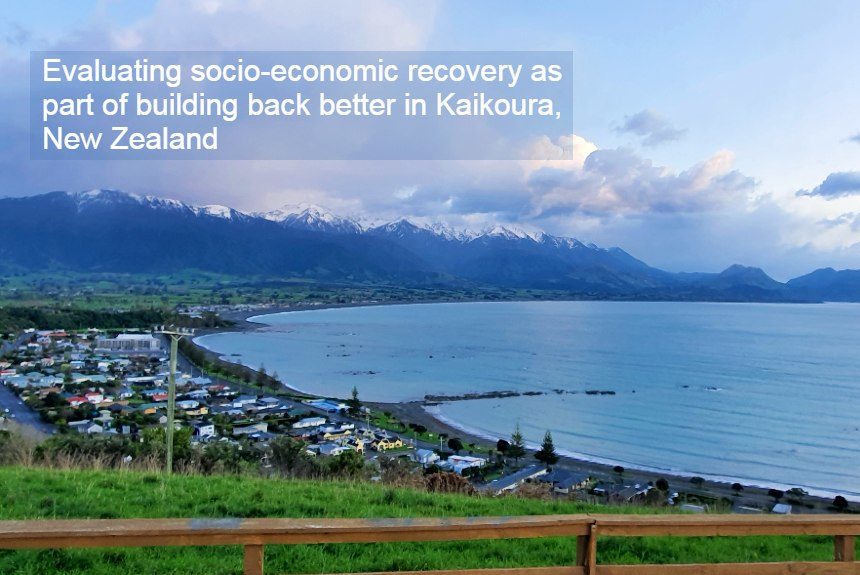The need for a Post-Disaster Recovery framework has never been more critical in the face of the increased risk and threats posed by climate change and natural disasters.
A successful post-disaster recovery framework addresses the rehabilitation of physical structures and communities’ psychological, social, and economic recovery, making it a holistic approach.
In 2016, a 7.8-magnitude earthquake struck Kaikoura, a small tourism-based town on the east coast of New Zealand’s South Island. The event caused 80,000 landslides, damaged buildings, injured 50 people, and killed two people.
Damage to infrastructures like roads, bridges, rail, and ports was also severe. The town was isolated from the rest of the country for 2 days, making it very challenging to send immediate support and relief following the disaster.
Aside from earthquakes, the town is also susceptible to wildfires and landslides, hazards that climate scientists project to increase in severity and frequency due to climate change.
The study examined Kaikoura’s post-disaster socio-economic activities and its best-practice psychosocial and economic recovery indicators.
The paper also evaluates the framework’s applicability and usefulness in future post-disaster recovery planning.
About the BBB Framework
Sandeeka Mannakarra and Suzanne Wilkinson developed the Build Back Better Framework based on the Build Back Better concept. It covers all of its features for a resilient post-disaster recovery of communities affected by disasters.
The framework comprises three approaches – Disaster Risk Reduction, Community Recovery, and Effective Implementation. Each approach contains eight BBB principles described in the study.
The second dimension, community recovery, is the focus of the research and refers to the psychosocial and economic support given to those impacted by a disaster.
Why are psychosocial and economic aspects necessary in the post-disaster recovery process?
The researchers referred to Chang, Wilkinson, Potangaroa, and Seville’s study to explain why the psychosocial and economic aspects are crucial to post-disaster recovery.
After the 2009 Victorian bushfire, the trauma and social changes that the community experienced hampered the housing rebuilding and recovery process, causing them to be indecisive, confused, and unable to move.
The study provides examples of how psychosocial and economic support by the central government and institutions is critical in helping communities recover successfully after a disaster, citing the Indonesian government’s psychosocial support extended to Yogyakarta province after the 2006 earthquake and the 2010 volcanic eruption.
Following Hurricane Katrina’s destruction in 2005, the US government provided economic support in the form of bonuses and wages to facilitate rebuilding in Louisiana.
A sense of ownership by the community in the post-disaster recovery efforts by allowing them to have a say in any restoration decisions and plans will also lead to a successful post-disaster recovery operation.
The study also features the importance of having legislation and policies in place to support post-disaster recovery measures. The government can even take this step further by creating future economic opportunities for the communities to help in their long-term recovery.
The study highlights Kaikoura’s best practices regarding its psychological and social recovery after the earthquake. After a disaster, the community requires support at various levels.
When the earthquake struck Kaikoura, the community of 3800 was disconnected from the rest of the country for two days due to damage to the road and rail network. Disruption at the seafloor made it hard for relief ships to reach the community.
Consequently, the Kaikoura District Council welcomed the chance to use the Build Back Better Framework for their post-disaster recovery efforts and make the city more resilient to future disasters.
The study finds that Kaikoura’s psychosocial and economic post-disaster recovery aligned with the BBB Framework indicators and their relevance in assessing and planning recovery. Psychological and social wellbeing and recovery were central to Kaikoura’s recovery, which was implemented by their local council.
Examples of these actions include providing psychological counselling services to reach out to affected households, free legal advice on insurance, rebuilding, and other housing queries that communities need, and earthquake and other community funds to support the recovery of the local community.
Overall, the study participants, those who were involved in and implemented the post-disaster recovery operations in Kaikoura, agreed that the BBB indicators for psychosocial and economic recovery were valuable and applicable to a positive outcome for Kaikoura.
To read the entire study, click the link below.
Source:
Neeraj, S., Mannakkara,S., & Wilkinson, S. (2020, January 6). Evaluating socio-economic recovery as part of building back better in Kaikoura, New Zealand, International Journal of Disaster Risk Reduction, Volume 52, 2021, 101930, ISSN 2212-4209, https://doi.org/10.1016/j.ijdrr.2020.101930



Leave a Reply